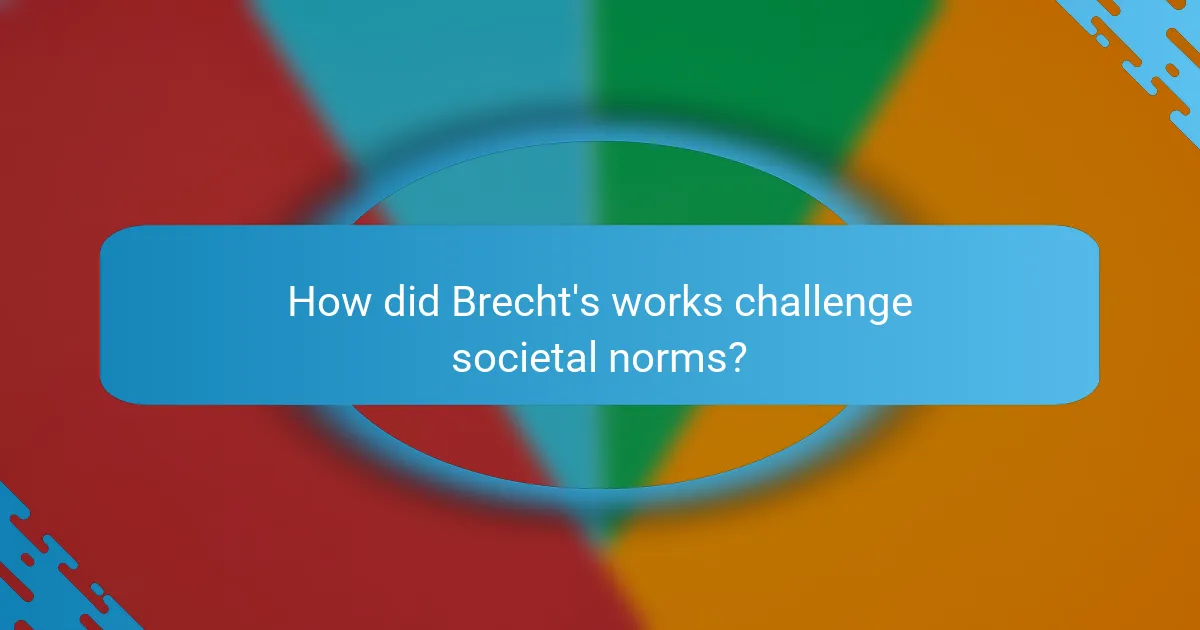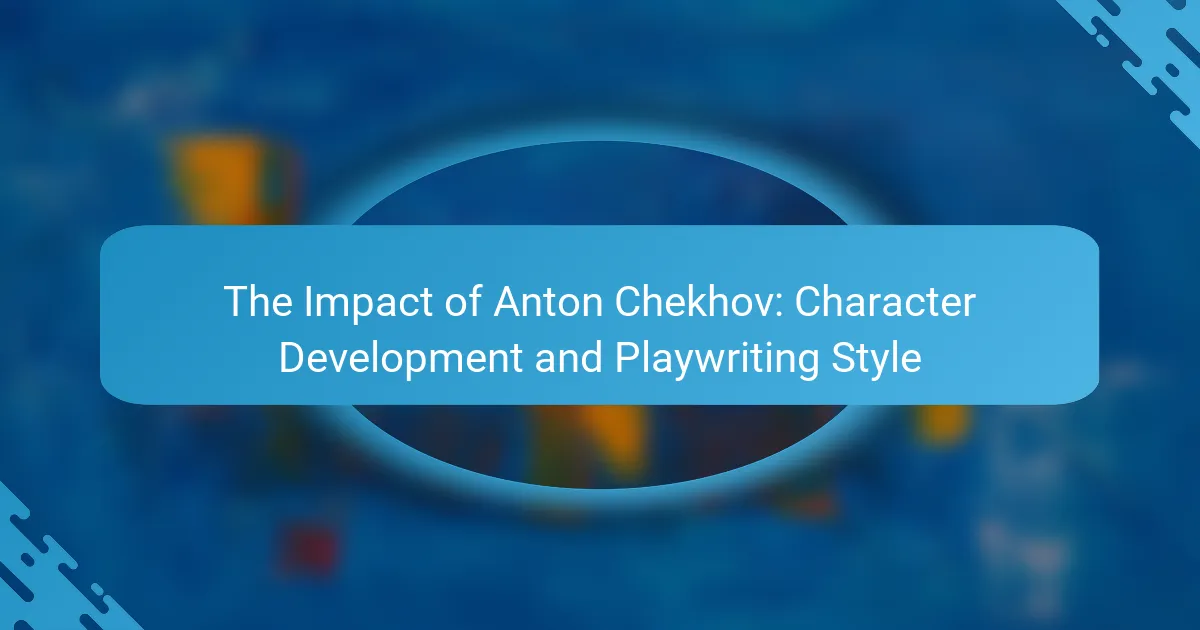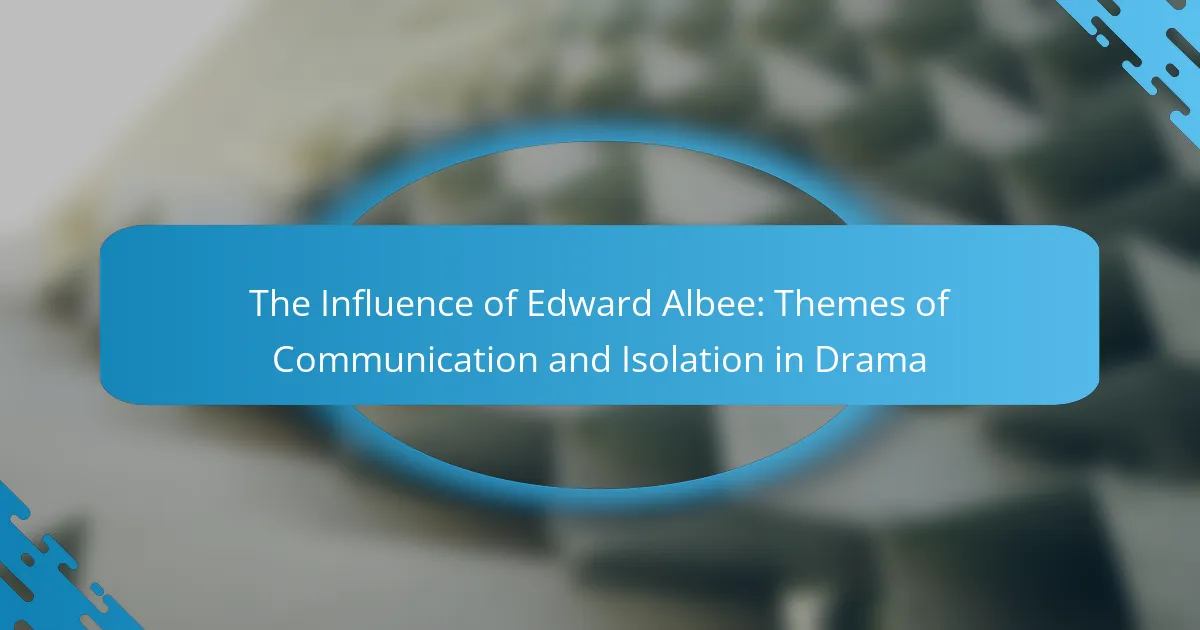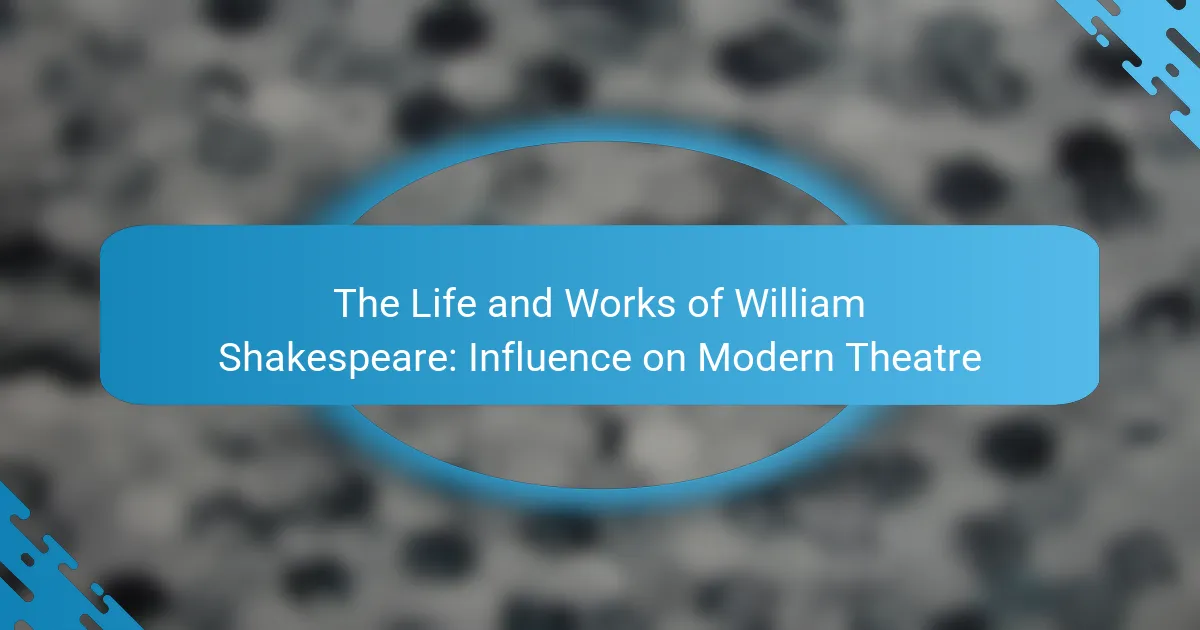Bertolt Brecht is a pivotal figure in the realm of political theatre, renowned for his innovative epic techniques that emphasize critical engagement. His concept of “Verfremdungseffekt,” or alienation effect, is designed to provoke thought and encourage audiences to question societal norms, rather than passively identify with characters. Brecht’s notable works, including “Mother Courage and Her Children” and “The Threepenny Opera,” address social and political issues, focusing on class struggles and injustices. His influence extends into contemporary theatre practices, where his methods continue to inspire playwrights and educators to foster critical thinking and social awareness through performance. Brecht’s legacy remains significant in shaping theatre as a medium for social commentary and change.

What is the Legacy of Bertolt Brecht?
Bertolt Brecht’s legacy is characterized by his revolutionary contributions to political theatre and epic techniques. He introduced the concept of “Verfremdungseffekt,” or alienation effect, which encourages critical thinking in audiences. Brecht’s works often addressed social issues and aimed to provoke political change. His plays, such as “Mother Courage and Her Children,” exemplify his focus on the struggles of the common people. Brecht’s influence extends beyond theatre, impacting literature, film, and music. He emphasized the importance of audience engagement and interaction. His methods have inspired countless playwrights and directors globally. Brecht’s legacy continues to resonate in contemporary theatre practices today.
How did Bertolt Brecht influence political theatre?
Bertolt Brecht significantly influenced political theatre through his development of the Epic Theatre concept. This approach emphasized the social and political context of performances. Brecht aimed to provoke critical thinking rather than emotional engagement. He introduced techniques like the Verfremdungseffekt, or “alienation effect,” to distance the audience from the narrative. This encouraged viewers to reflect on societal issues rather than passively absorb the story. His works, such as “The Threepenny Opera,” highlighted class struggles and capitalism’s flaws. Brecht’s methods have inspired generations of playwrights and theatre practitioners to address political themes. His influence is evident in contemporary political theatre worldwide.
What are the key characteristics of Brecht’s political theatre?
Brecht’s political theatre is characterized by its emphasis on social critique and audience engagement. It seeks to provoke critical thought rather than emotional immersion. The use of the “Verfremdungseffekt,” or alienation effect, disrupts the audience’s passive viewing. This technique encourages spectators to reflect on the social and political implications of the performance. Brecht often employed non-linear narratives and episodic structures. These elements highlight the complexity of societal issues. His works frequently incorporate direct address and multimedia elements. This approach fosters a dialogue between the performers and the audience. Brecht’s political theatre ultimately aims to inspire social change through awareness and action.
How did Brecht’s personal experiences shape his theatrical approach?
Bertolt Brecht’s personal experiences significantly influenced his theatrical approach. His early exposure to the socio-political climate of Germany shaped his views on art as a tool for social change. The rise of fascism and his subsequent exile prompted him to explore themes of alienation and critical engagement in theatre. Brecht’s experiences during World War I informed his belief in the importance of addressing societal issues through performance. He developed the concept of “Verfremdungseffekt,” or the “distancing effect,” to encourage audiences to think critically rather than passively consume art. His interactions with Marxist ideology further solidified his commitment to creating politically charged works. Brecht’s personal struggles and observations led him to prioritize the role of the audience in shaping the meaning of his plays. His life experiences were thus integral to his development of epic theatre, which aimed to provoke thought and inspire action.
What are the foundational concepts of Brecht’s epic techniques?
Brecht’s epic techniques are founded on the concepts of alienation, social critique, and non-linear narrative. Alienation, or “Verfremdungseffekt,” encourages audiences to critically engage rather than become emotionally absorbed. This technique prompts viewers to question societal norms and ideologies. Social critique is central to Brecht’s work, as it aims to expose social injustices and provoke change. Non-linear narrative structures disrupt traditional storytelling, allowing for a more analytical approach to the material. Brecht’s techniques emphasize the importance of audience awareness and active participation in the theatrical experience. These foundational concepts are integral to the legacy of Brecht’s political theatre.
What distinguishes epic theatre from traditional theatre?
Epic theatre is distinguished from traditional theatre by its emphasis on social and political messages. Traditional theatre often seeks to create emotional engagement and illusion, immersing the audience in the narrative. In contrast, epic theatre aims to provoke critical thinking and self-reflection among viewers.
Bertolt Brecht, the founder of epic theatre, employed techniques such as alienation and interruption to achieve this. These methods encourage the audience to question the actions and motivations of characters. Brecht believed that theatre should be a platform for social change, contrasting with traditional theatre’s focus on entertainment.
Epic theatre often includes direct addresses to the audience, breaking the fourth wall. This approach invites spectators to engage intellectually rather than emotionally. Historical examples include Brecht’s own plays, such as “Mother Courage and Her Children,” which highlight societal issues.
This distinction between engaging the audience emotionally versus intellectually is a core tenet of epic theatre.
How do Brecht’s techniques promote critical thinking in audiences?
Brecht’s techniques promote critical thinking in audiences by encouraging active engagement with the material. He utilized the concept of Verfremdungseffekt, or alienation effect, to create distance between the audience and the characters. This technique prevents emotional immersion and prompts viewers to analyze the social and political implications of the narrative. Brecht incorporated direct address and interruptions in the performance to challenge conventional storytelling. These methods stimulate reflection and critique rather than passive consumption of the play. His works often included historical context and social commentary, making audiences question societal norms. By presenting complex issues without clear resolutions, Brecht invites audiences to form their own opinions. This approach fosters a critical perspective on the world around them.
Why is Brecht’s legacy significant in contemporary theatre?
Brecht’s legacy is significant in contemporary theatre due to his innovative techniques and political engagement. His concept of the “alienation effect” encourages audiences to critically engage with performances. This technique disrupts emotional immersion, prompting reflection on societal issues. Brecht’s emphasis on social critique remains relevant in today’s political climate. Many contemporary playwrights and directors draw inspiration from his methods. Productions often incorporate Brechtian elements to challenge audiences. His influence can be seen in various genres, including experimental and documentary theatre. Brecht’s work continues to provoke discussions about art’s role in society.
What modern playwrights have been influenced by Brecht?
Modern playwrights influenced by Bertolt Brecht include Tony Kushner, David Mamet, and Sarah Kane. Tony Kushner, known for “Angels in America,” incorporates Brechtian techniques to address social issues. David Mamet employs a fragmented style that reflects Brecht’s influence on dialogue and structure. Sarah Kane’s work, particularly “Blasted,” challenges audience perceptions in a manner reminiscent of Brecht’s epic theatre. These playwrights utilize Brecht’s methods to provoke thought and engage critically with political themes.
How do current political movements reflect Brecht’s theatrical principles?
Current political movements often embody Brecht’s theatrical principles through their emphasis on social critique and audience engagement. Brecht advocated for a form of theatre that provokes thought rather than emotional immersion. Many contemporary movements utilize performance art and public demonstrations to challenge societal norms. This approach encourages spectators to reflect critically on political issues. For instance, the use of direct action in protests mirrors Brecht’s idea of ‘Verfremdungseffekt’ or alienation effect. This technique aims to prevent the audience from becoming too emotionally involved. Instead, it encourages them to analyze the underlying social dynamics. Movements such as Black Lives Matter employ art and theatre to highlight systemic injustices. This creates a space for dialogue and reflection, aligning with Brecht’s vision of theatre as a tool for social change.

How did Brecht’s works challenge societal norms?
Brecht’s works challenged societal norms by promoting critical thinking and social change through theatre. He utilized the concept of “Verfremdungseffekt,” or alienation effect, to encourage audiences to question their realities. This technique disrupted traditional narrative forms and prevented emotional identification with characters. Brecht’s plays often addressed political issues, highlighting class struggles and societal injustices. For instance, “The Threepenny Opera” critiques capitalism and morality. His approach to theatre emphasized the role of the audience as active participants rather than passive viewers. This innovative style aimed to provoke thought and inspire action against oppressive systems. Through his works, Brecht fundamentally transformed the expectations of theatre as a medium for social commentary.
What themes are prevalent in Brecht’s most famous plays?
Brecht’s most famous plays often explore themes of alienation, social injustice, and the critique of capitalism. Alienation is a central theme, encouraging audiences to critically engage with the performance rather than become emotionally absorbed. Social injustice is highlighted through characters and narratives that showcase class struggles and exploitation. The critique of capitalism is evident in plays like “The Threepenny Opera,” which examines the moral decay associated with capitalist society. Brecht’s works often promote the idea of political awareness and action, urging audiences to reflect on societal issues. These themes are consistently present across his significant works, reinforcing his legacy in political theatre.
How does Brecht address issues of class and power in his works?
Brecht addresses issues of class and power through his concept of epic theatre. He employs techniques that encourage critical thinking and audience engagement. Brecht’s works often depict the struggles between social classes. He highlights the exploitation inherent in capitalist societies. For instance, in “The Threepenny Opera,” he critiques the relationship between crime and capitalism. Brecht uses alienation effects to challenge audience complacency. This technique prompts viewers to question societal norms and power structures. His characters often represent broader social issues rather than individual psychology. Through these methods, Brecht effectively critiques the dynamics of class and power.
What role does alienation play in Brecht’s storytelling?
Alienation plays a crucial role in Brecht’s storytelling by creating distance between the audience and the characters. This technique, known as “Verfremdungseffekt” or the alienation effect, encourages critical thinking. Brecht aimed to prevent emotional identification with characters. Instead, he wanted audiences to engage intellectually with the social and political themes presented. This approach allows viewers to reflect on societal issues rather than simply experiencing the narrative. Brecht’s use of alienation can be seen in his plays, such as “Mother Courage and Her Children.” The characters often break the fourth wall, directly addressing the audience. This method reinforces the idea that the stories are not just entertainment but a call to action.
What techniques did Brecht use to engage and provoke audiences?
Bertolt Brecht employed several techniques to engage and provoke audiences. He utilized the concept of “Verfremdungseffekt,” or the alienation effect, to prevent emotional identification with characters. This technique encouraged critical observation rather than emotional involvement. Brecht also integrated direct address, where actors spoke directly to the audience, breaking the fourth wall. This approach fostered a sense of participation and reflection on societal issues. Additionally, he used episodic structure in his plays, which fragmented storytelling to highlight social themes. Brecht’s incorporation of multimedia elements, such as music and projections, further stimulated audience engagement. These techniques collectively aimed to provoke thought and inspire social change.
How does the use of music and song enhance Brecht’s message?
The use of music and song enhances Brecht’s message by creating emotional distance and promoting critical engagement. Brecht employed music to disrupt the audience’s immersion in the narrative. This technique encourages viewers to reflect on the social and political issues presented. Songs often contained ironic or contradictory lyrics that highlighted the absurdity of the situations. For example, in “The Threepenny Opera,” the music contrasts with the dark themes of the story. This juxtaposition prompts audiences to question the moral implications of the characters’ actions. By integrating music, Brecht aimed to provoke thought rather than emotional catharsis. This approach aligns with his goal of fostering social change through awareness.
What is the significance of direct address in Brecht’s theatre?
Direct address in Brecht’s theatre serves to engage the audience actively. It breaks the fourth wall, prompting viewers to think critically about the performance. This technique encourages spectators to analyze social and political issues presented on stage. By addressing the audience directly, Brecht aims to foster a sense of awareness and reflection. Historical context shows that this method was part of his epic theatre approach. Epic theatre sought to challenge traditional narrative forms and provoke thought rather than emotional involvement. Brecht believed that emotional detachment would lead to greater intellectual engagement. This approach is significant in promoting political consciousness and social change.

What are the practical applications of Brecht’s techniques today?
Brecht’s techniques are applied in various contemporary theatrical practices. They are used to promote critical thinking among audiences. Techniques like the alienation effect encourage viewers to question societal norms. Many modern playwrights utilize Brecht’s methods to address political issues. These techniques are also evident in multimedia performances. They enhance the audience’s engagement through diverse forms of storytelling. Additionally, Brecht’s techniques influence educational theatre programs. They help students explore social justice themes through performance.
How can modern theatre practitioners implement Brechtian techniques?
Modern theatre practitioners can implement Brechtian techniques by emphasizing the concept of Verfremdung, or estrangement. This involves creating a distance between the audience and the performance. Practitioners can achieve this through unconventional staging, such as using minimal sets and visible stage mechanics. They can also incorporate direct address to the audience, breaking the fourth wall. Additionally, using multimedia elements can disrupt traditional narrative flow. Practitioners should focus on presenting social and political issues to provoke critical thought. Brecht’s techniques encourage audiences to question societal norms rather than passively consume the performance. Historical examples include the use of songs and narration to comment on the action, as seen in Brecht’s own works like “The Threepenny Opera.” These methods foster engagement and reflection, aligning with Brecht’s vision of theatre as a tool for social change.
What are effective strategies for incorporating alienation effects in performances?
Effective strategies for incorporating alienation effects in performances include breaking the fourth wall and using direct address. This technique engages the audience and prompts critical reflection. Another strategy is employing stark lighting and minimal sets. These choices create a sense of distance between the audience and the performance. Additionally, actors can use exaggerated gestures and varied vocal styles. This approach highlights the artificiality of the performance. Incorporating multimedia elements can also enhance alienation effects. For example, projected images can disrupt narrative flow and encourage viewer analysis. Brecht’s own works, such as “Mother Courage,” exemplify these techniques. They effectively challenge audiences to question societal norms and ideologies.
How can educators use Brecht’s methods to teach critical thinking?
Educators can use Brecht’s methods to teach critical thinking by employing techniques such as alienation effects and participatory dialogue. Alienation effects encourage students to question the narrative and societal norms presented in plays. This method prompts critical reflection rather than passive consumption of information. Participatory dialogue allows students to engage actively with the material. It fosters discussion and debate, enhancing their analytical skills.
Brecht’s emphasis on questioning and reflection is rooted in his belief that theatre should provoke thought. For example, his plays often include direct addresses to the audience, prompting them to consider their own beliefs and actions. This approach can be adapted in the classroom through discussions that challenge students to articulate their viewpoints.
Additionally, educators can incorporate Brecht’s use of historical context in lessons. This method helps students draw connections between the material and contemporary issues. By analyzing characters and situations in a critical light, students develop a deeper understanding of the complexities of social and political themes.
Using these techniques, educators can create a dynamic learning environment that promotes critical thinking and encourages students to become active participants in their education.
What challenges do contemporary artists face when adapting Brecht’s style?
Contemporary artists face several challenges when adapting Brecht’s style. One challenge is the complexity of Brecht’s techniques, such as alienation and non-linear narratives. These methods require a deep understanding and innovative application to resonate with modern audiences. Another challenge is the political context; Brecht’s work was rooted in specific historical events. Artists must navigate contemporary political landscapes that may differ significantly from Brecht’s time. Additionally, Brecht’s emphasis on audience engagement demands a shift in how performances are traditionally structured. Artists must create interactive experiences that provoke thought rather than simply entertain. The balance between maintaining Brecht’s original intent and making the work relevant today is also difficult. Overall, adapting Brecht’s style requires both artistic skill and a nuanced understanding of current societal issues.
How can artists maintain the integrity of Brecht’s vision in modern contexts?
Artists can maintain the integrity of Brecht’s vision in modern contexts by utilizing his techniques of alienation and critical engagement. They should focus on creating works that encourage audiences to think critically about societal issues. Brecht emphasized the importance of not just entertaining but provoking thought and discussion. Incorporating multimedia elements can enhance this engagement, making the audience aware of the constructed nature of the performance.
Using contemporary themes relevant to current social and political climates can also help connect Brecht’s ideas to modern audiences. Collaborating with diverse communities ensures a broader perspective and relevance. Additionally, artists should avoid traditional narrative structures that promote passive viewing. Instead, they can adopt fragmented storytelling to challenge audience perceptions, aligning with Brecht’s intent to disrupt complacency.
By embracing these methods, artists can honor Brecht’s legacy while making his vision applicable to today’s world.
What resources are available for learning about Brecht’s techniques?
Books on Brecht’s techniques include “Brecht on Theatre” edited by John Willett. This compilation contains key writings by Brecht himself. “The Threepenny Opera” offers insight into his style and political themes. Additionally, “Brecht: A Biography” by Stephen Parker provides context about his life and methods. Online resources such as the Brecht Archive offer extensive materials. Universities often provide courses focused on Brecht’s techniques in political theatre. Workshops and seminars conducted by theatre companies also explore his methods. These resources collectively enhance understanding of Brecht’s innovative approaches to theatre.
What are best practices for creating politically charged theatre today?
Best practices for creating politically charged theatre today include engaging with current social issues. This involves researching relevant topics to ensure authenticity. Collaborating with diverse voices enhances representation and perspective. Utilizing Brechtian techniques, such as alienation effects, encourages critical thinking among audiences. Interactive elements can foster audience participation and reflection. Incorporating multimedia can amplify messages effectively. Maintaining a clear artistic vision helps unify the production’s message. Regular feedback from community members can ensure relevance and impact.
The main entity of the article is Bertolt Brecht, a pivotal figure in political theatre known for his epic techniques. The article explores Brecht’s revolutionary contributions, including the concept of “Verfremdungseffekt” or alienation effect, which promotes critical thinking in audiences. It details how his works address social issues, challenge societal norms, and inspire political change through innovative storytelling methods. Key characteristics of Brecht’s political theatre, his personal influences, and the lasting impact of his techniques on contemporary theatre practices are also examined. The article highlights the significance of Brecht’s legacy in shaping modern theatrical approaches and engaging with current social and political themes.



